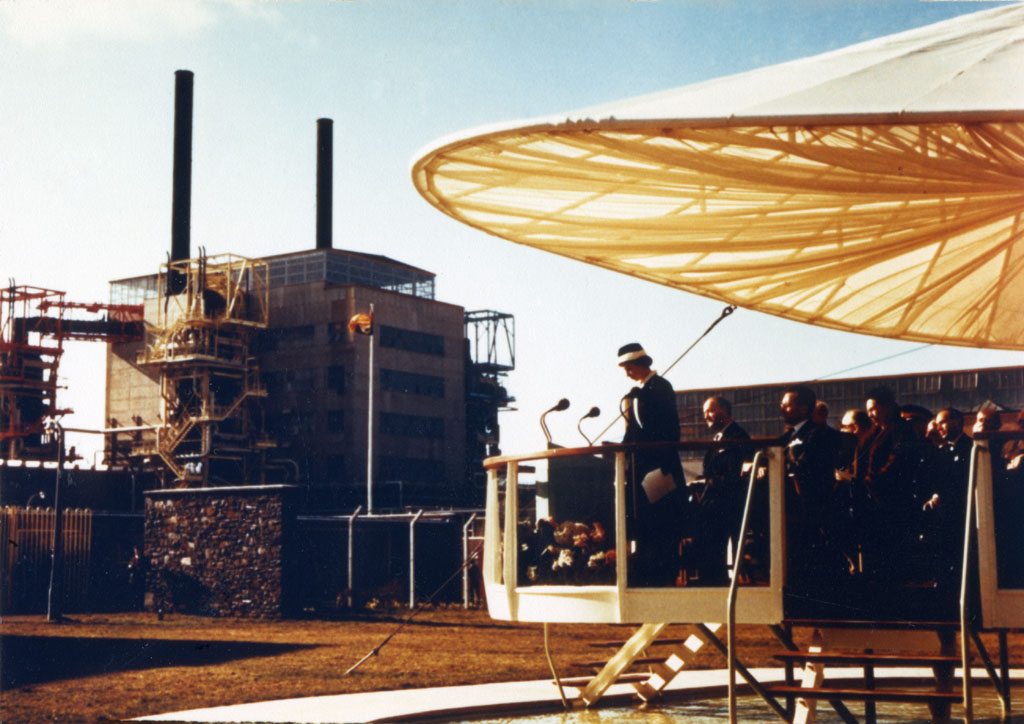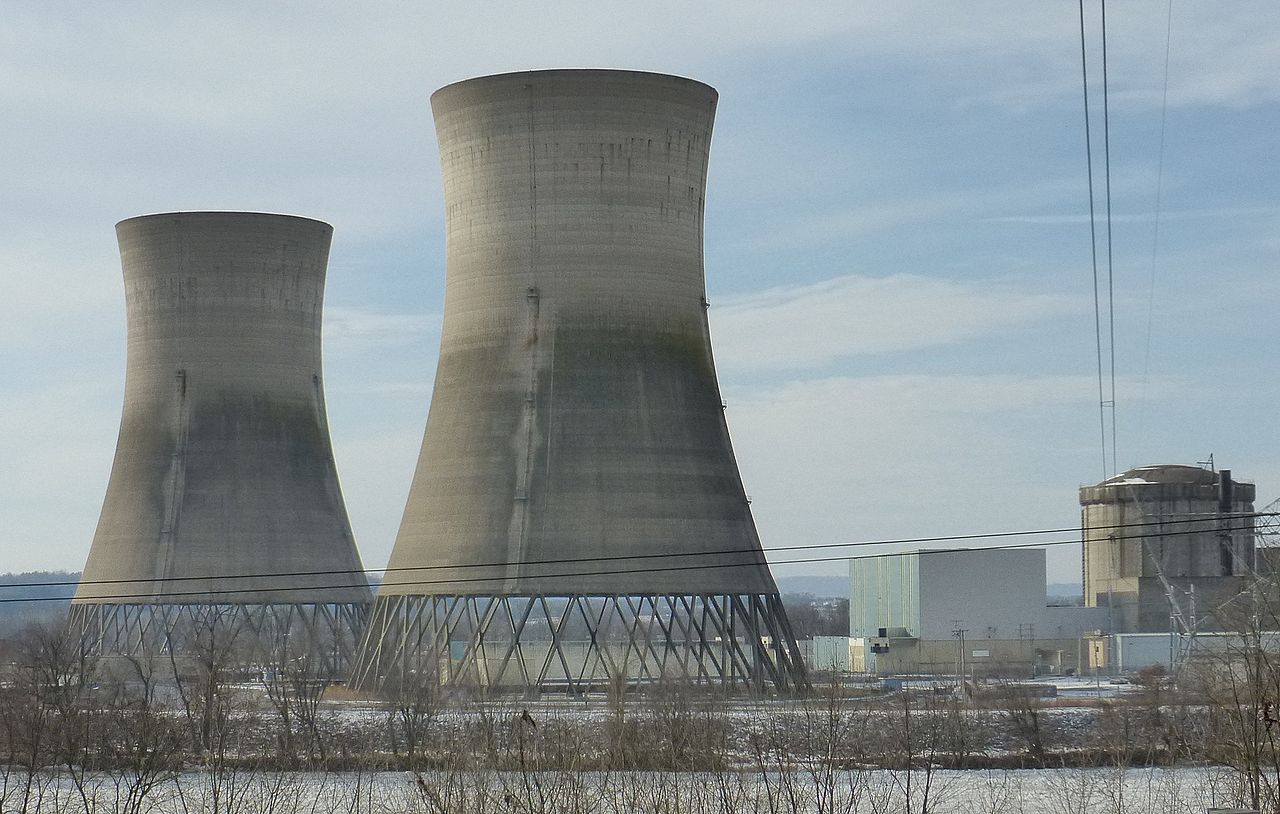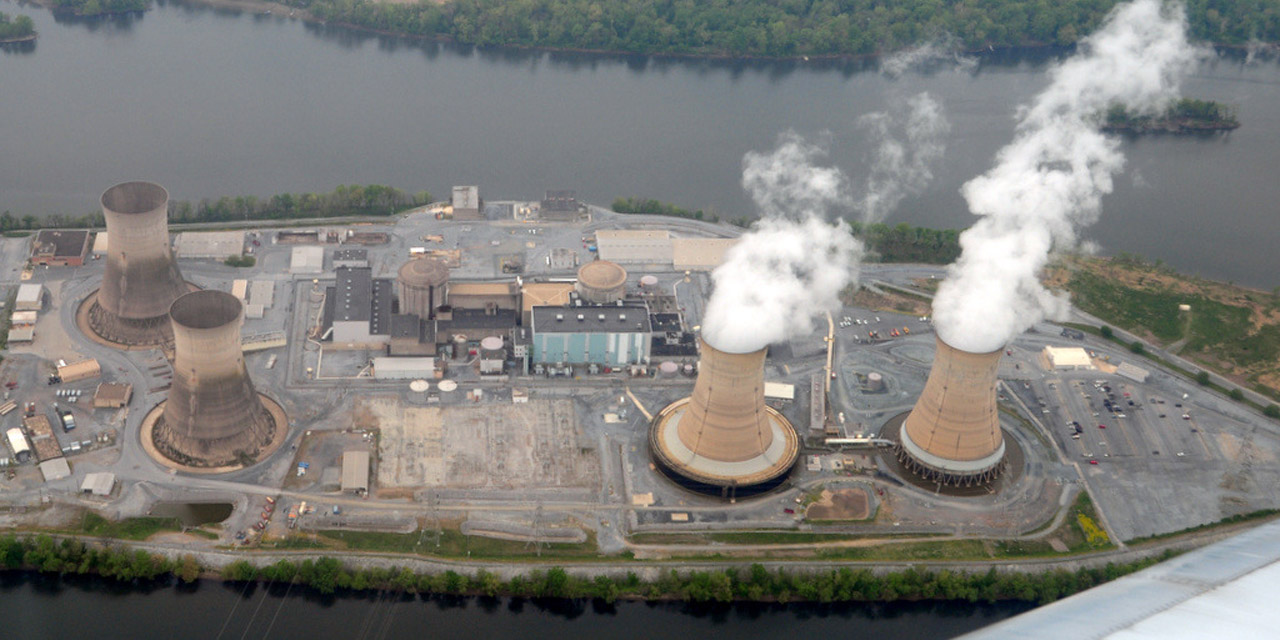Energy secretary Jennifer Granholm (in purple blazer) and the ANS-sponsored delegates pose in front of the Nuclear for Climate booth at COP27.
Nuclear energy is no longer on the fringes of the international climate conversation. At COP27, the United Nations climate change conference held in Sharm el-Sheikh, Egypt, from November 6 to 18, pronuclear advocates were everywhere—and they were talking to everyone. They populated the International Atomic Energy Agency’s #Atoms4Climate pavilion, the first-ever nuclear pavilion in the 27-year history of the negotiations. Echoing such strong representation, the final statement issued by the conference used language that included nuclear power.
Queen Elizabeth II visits Calder Hall for its ceremonial opening in 1956. (Photo: U.K. Nuclear Decommissioning Authority)
As citizens of the United Kingdom and others around the world mourn the death of Queen Elizabeth II, many have reflected on how the world has changed during the seven decades of the queen’s reign—the same decades that saw the rise of civilian nuclear power.
Calder Hall was already under construction at the Sellafield site in West Cumbria when Princess Elizabeth became queen in 1953. Queen Elizabeth traveled to the site in October 1956 and declared, in a televised ceremony, that “It is with pride that I now open Calder Hall, Britain’s first atomic power station.” Watch the fanfare in a historical clip uploaded to YouTube by Sellafield Ltd below.
America’s nuclear navy presently has 86 nuclear-powered submarines and aircraft carriers. All of them, and their predecessors over the last 60 years, have performed flawlessly, protecting America as well as their crews. Here, the nuclear submarine USS Seawolf leads the nuclear-powered aircraft carrier USS Nimitz and the conventionally powered Japan Maritime Self-Defense Force destroyer JS Oonami DD 111 during exercises in 2009. (Photo: United States Navy)
Just this last April, President Biden officially commissioned the USS Delaware, a new Virginia-class nuclear attack submarine, the 18th built in that class and the eighth and final Block III Virginia-class submarine. (The Delaware was administratively commissioned in April 2020, but the COVID-19 pandemic caused delay of the ceremony for two years.)
A view of the entrance to tower #22, showing the dismantled part of an inclined column.
While the construction of two additional reactors at Slovakia’s Mochovce nuclear plant (Units 3 and 4) may get most of the attention, it isn’t the only major project underway there. In October of last year, plant owner Slovenské Elektrárne commenced the first phase of an effort to revitalize two of the four 125-meter-tall, Iterson-type cooling towers that serve the facility’s two operating reactors—both of which began generating electricity in the late 1990s. Towers #11 and #21 had been refurbished in 2011 and 2012, respectively. The other two, however, towers #12 and #22, had never undergone refurbishment.
July 8, 2022, 7:00AMNuclear NewsBy George Apostolakis, James Ellis, and Steven Nesbit The Diablo Canyon nuclear power plant.
The state of California recently and quite sensibly cracked the door back open for continued operation of the Diablo Canyon nuclear power plant past the current operating license expiration dates in 2024 (Unit 1) and 2025 (Unit 2). The nonprofit North American Electric Reliability Corporation’s recently released 2022 Summer Reliability Assessment highlights the risk of electricity shortages in California. Given that concern, as well as the benefits of continued Diablo Canyon operation—including much needed clean, reliable energy; good jobs; and potential for large-scale production of fresh water—another look at the shutdown decision made several years ago is clearly warranted. Sen. Dianne Feinstein (D., Calif.) reinforced this point when she added her voice to the growing chorus of policymakers advocating extended operation for Diablo Canyon.
Panelists (from left) Adam Stein, Jon Ball, Mike Laufer, and Michl Binderbauer during the Breaking Through: Assessing the Current State and Prospects of Nuclear Innovation in the Race to Decarbonize session at the ANS Annual Meeting.
If nuclear innovators are in a race to decarbonize, it is a race with one finish line—affordable, clean, and reliable power—and many ways to get there. Over 40 fission developers and 20 fusion developers are in the running, and while attendees of the June 13 ANS Annual Meeting executive session on Breaking Through: Assessing the Current State and Prospects of Nuclear Innovation in the Race to Decarbonize heard from representatives of just three of those companies, they presented very different designs and deployment approaches, aptly reflecting the broader diversity of nuclear power innovation.
Session chair Adam Stein, director of nuclear energy innovation at the Breakthrough Institute, welcomed representatives from an advanced non–light water reactor developer (Mike Laufer, Kairos Power), a small modular light water reactor developer (Jon Ball, GE Hitachi Nuclear Energy), and a fusion power developer (Michl Binderbauer, TAE Technologies). Together they explored the challenge of engineering a significant commercial scale-up of advanced nuclear technology by the end of the decade, tackling questions of cost, schedule, supply chain, regulation, and more.
The cooling towers of Unit 2 at Three Mile Island Nuclear Generating Station, closed since the accident in 1979.
The Three Mile Island accident in 1979 was the most-studied nuclear reactor event in the U.S. There is a plethora of research about the accident available to the general public, including the president-appointed Kemeny Commission report and the Nuclear Regulatory Commission’s Rogovin inquiry report (split into volume one, and volume two, parts one, two, and three), which are the two detailed government-sponsored investigations into the accident. There are also thousands of documents in the NRC’s ADAMS database available to the public, an excellent overview by NRC historian Samuel Walker Three Mile Island: A Nuclear Crisis in Historical Perspective, as well as the Nuclear News special report from April 1979, and articles written by ANS members like William Burchill about the accident and the many changes it forced on the industry. If the producers of Meltdown: Three Mile Island—available on Netflix—had read any of those documents instead of relying mostly on input from antinuclear activists, their “documentary” might have been presented with at least some sense of balance and credibility.
Instead, similar to a recent Science Channel documentary on the Three Mile Island accident, Meltdown focuses on drama instead of science. This four-part miniseries does not attempt to provide a balanced set of facts from the technical community and instead relies heavily on nonexpert opinions and anecdotal statements to tell a story that easily falls apart under even the faintest scrutiny.
Nuclear News reached out to multiple ANS members who were involved with either the accident response or the clean up to help provide a critical look at some of the more egregious statements made in the documentary.
The accident at Three Mile Island revealed many areas for improvement in the safety of nuclear power that have been addressed continuously in the past 40 years.
Part one of this article, published in the May 2019 issue of Nuclear News[1] and last Friday on Nuclear Newswire, presented insights from the 1979 accident at Three Mile Island-2 and addressed several issues raised by a previous Nuclear News piece on the accident[2]. Part two discusses safety improvements that have been made by both the industry and the Nuclear Regulatory Commission over the past 40 years.
Sparked by an article on the TMI accident that appeared in the March 2019 issue of Nuclear News, ANS past president William E. Burchill (2008–2009) offered his own views on the subject. Part 1 of the article appeared in the May 2019 issue of NN and Part 2 was published in June 2019.
The accident at Unit 2 of the Three Mile Island nuclear power plant on March 28, 1979, was an extremely complex event. It was produced by numerous preexisting plant conditions, many systemic issues in the industry and the Nuclear Regulatory Commission, unanticipated operator actions, previously unrecognized thermal-hydraulic phenomena in the reactor coolant system (RCS), and the unprecedented challenge of managing a severely degraded core.














